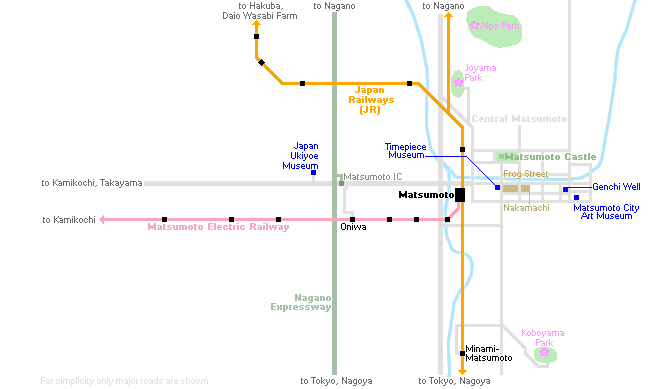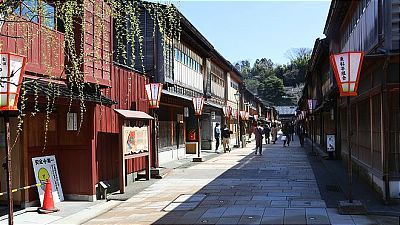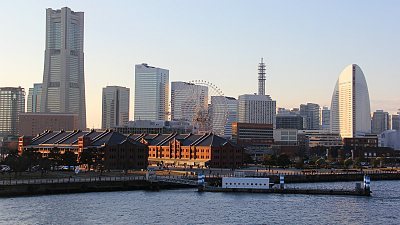A Stroll Through Matsumoto

Standing as the second largest city in Nagano Prefecture Matsumoto boasts a centuries-long history that shows in its architecture, including a famous castle and the city's merchant district. Add to its old streets a string of chic cafes and boutique stores, sophisticated restaurants, and splashes of modern art, and you have one of the best examples in the country of a place that blends the old with the new to create its own, very distinct personality.
Having been to Matsumoto various times throughout my time at japan-guide.com to report on the cherry blossoms, today I was looking forward to taking a stroll through this old city to explore it in a different way, and perhaps gain a more in-depth understanding of it.

After arriving in Matsumoto, I immediately headed to the most famous of all the city's points of interest, the revered Matsumoto Castle. This castle is one of only twelve in the country whose keep has survived since the Edo Period, and it is commonly rated as among the very best and most impressive castles in Japan.
I can honestly say that over the course of my numerous visits to the castle, it has never ceased to impress me with its jet black walls and imposing silhouette against a backdrop of the Japanese Alps. Today was my first time to visit during the early summer however, and I found that the offering of vivid, in-bloom flowers beneath the bright blue sky made the castle grounds seem a little less austere than usual.


After strolling around the pleasant grounds for a few minutes, I made my way towards the castle itself, which is open for the public to enter. It was a little busy on the way up to the top-floor viewing area, but the bustle was worth it for the views of the city and mountains that I was treated to from the top.
In addition to taking in the views, I took great pleasure in navigating the castle's interior, which is almost exclusively wooden with a series of steep staircases that lead visitors up through the levels, just as in the feudal era. The old atmosphere within these walls allowed me to really appreciate how old the castle is, with one of its buildings even dating back to the year 1592!


From the castle I strolled through downtown Matsumoto before arriving at the end of Frog Street, the next stop on today's exploration of the city. To my delight, there was a small market in progress, with stalls selling a selection of stylish crafts, retro knick-knacks and old memorabilia.
I took a minute to soak up the bohemian vibe of the place, and then bought some freshly squeezed fruit soda from one of the vendors to quench my first under the early afternoon sun. The juice did the trick and I bade farewell to the market and began up Frog Street.



Vendors sprang up along this famous street when adjacent Yohashira Shrine was built in the Meiji Period and the street became the shrine's main approach. With so much business here, this street was a place where you could buy goods and also go home after worshipping. Because the Japanese words for "to buy" and "to go home" are phonetically identical to the word for "frog", the street acquired its amphibious nickname, and today many frog images can be seen along the street, adding to its fun and quirky atmosphere.
I was pleased that Frog Street was rather lively, and I relished the chance to saunter up the street towards the shrine as I peered into the various shops that purvey a plethora of crafts and souvenirs.



At the end of Frog Street I turned left and crossed the Metoba River that bisects the downtown area to arrive in Nakamachi, the old merchant district of Matsumoto. "Kura" are a distinct style of clay warehouses in which merchants nationwide used to store their goods in centuries past so as to protect them from fire. Nakamachi contains many well preserved old kura buildings, especially on its central Nakamachidori street.
Some even dating back as far as the feudal era, the kura in this part of town today house an eclectic variety of cute cafes, a la mode restaurants and boutiques purveying fashion, crafts and furniture.
I took a lot of pleasure in walking around the area and popping in and out of different shops. With old buildings playing host to such stylish, artsy establishments, this part of town particularly exudes the atmosphere of "old meets new" that epitomizes Matsumoto.




It was now getting towards mid-afternoon, and the early summer sun that was gentle when I arrived in town had since turned fierce, so I decided now would be a great time to grab lunch. I decided to eat at Kura, a sushi restaurant housed in an approximately one hundred-year old kura, just a few steps from Nakamachidori Street. I sat down and admired the atmospheric restaurant's sophisticated dark-wood interior before ordering a delicious looking sushi set.
After enjoying a top-quality selection of sushi that included salmon, tuna, squid and eel to name a few, I got talking to the chef about the building we were in, and he told me that years ago, it was located slightly to the west of where it is now, but was moved when the lane it previously stood along was widened into a road. This conversation made me consider Matsumoto's evolution from a feudal town to a stylish, modern city.




After my lunch at Kura, I made the short walk over to another of the city's popular sites, the Matsumoto Timepiece Museum. As the name suggests, this museum is dedicated to the evolution of clocks and watches, and showcases a large selection of timepieces from different countries and from various periods throughout history up to the present day.
I particularly enjoyed admiring the clocks from centuries ago and noted how intricately designed some of them were. I certainly recommend this place for clock fanatics and those that have (or indeed are in search of) the time.


From one museum to another, the next spot on today's itinerary was somewhere I had been particularly looking forward to visiting, the Matsumoto City Art Museum. This museum is dedicated to artists associated with the city of Matsumoto, and its main attraction is a permanent exhibition of of works from the world famous artist responsible for the iconic Yellow Pumpkin by Kusama Yayoi.
Born and raised in Matsumoto, Kusama developed her artistry in both Japan and the United States, and is known for her hallmark brightly colored and audaciously patterned art. The museum's collection includes an impressive selection of her quirky paintings and sculptures, and I can honestly say that walking around the exhibition space and getting up close to these pieces was a pleasure. This museum is must for any art fans visiting Matsumoto.



After the fun at the art museum, it was also time for me to leave Matsumoto, but I still had time before sunset to walk back towards Nakamachi to soak up the atmosphere one last time. Between the art museum and the old town I passed Genchi Well, which is another, much smaller land mark in the city.
The most famous well in Matsumoto, Genchi has provided the city's residents with wonderfully clear spring water for centuries, and today, local residents still come here to fill up bottles. Bidding farewell to the city for now, Matsumoto is a place I aim to return to in the near future.







